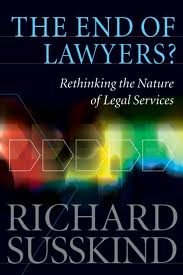 A while ago I finished reading The End of Lawyers? by Richard Susskind, at the recommendation of a friend. The author has a lot of experience working with and studying attorneys of all types throughout the world, though most of his own experience is in the UK. From the time he was still a student studying the usage of AI to create legal expert systems to his current posts as advisor about legal technology issues to many prominent groups including the UK government, Susskind has established himself as a proponent of using technology to allow lawyers to be more effective and to bring better access to legal service to the masses. The key piece of the book title is actually the question mark. Susskind does not use the book to argue why lawyers will disappear. He analyzes the legal profession as being affected by 9 major disruptions in technology or process and predicts what types of legal work will disappear (low-value, repetitive, and suitable for automation and outsourcing) and what types will carry on (high-value and based on individuals' unique experiences). In the book, Susskind does not actually recommend or suggest that people make any specific change or adopt any specific attitude. The book presents a fairly level-headed analysis but does give the author's opinions and predictions as to what he thinks will win out in the end in terms of the major trends affecting the legal industry. The 9 disruptive technologies studied in depth in the book are the following:
A common theme in the book is the analysis of a pair of related forces that Susskind argues will fundamentally transform legal service in the coming decade and beyond: a market demand for increasing commoditization of legal services and the widespread uptake of information technology. Susskind also presents an interesting "schedule" for the process by which he thinks legal services will evolve through (to various degrees or speeds depending on the service):
Susskind suggests to his clients that there are three basic options open to a law firm and its practice areas (with respect to these changes and adoption of technology). The first is the option to lead the way: to pioneer and play the role of first mover, enjoying the benefits and potential risks. The second option is to invest enough to be ready to respond in the event that a competitor or a new entrant jumps in more strongly later on. The hope is to avoid being left behind or to become a "fast second." The third option is to resist any move in adopting. This third option, Susskind argues, is "commercial suicide." Susskind also spends time analyzing who is driving innovation in the major areas of legal technology. Some of this is coming from law firms themselves and some from companies creating internal systems for their own use. He points out several times in his book that there are many opportunities for entrepreneurs outside of the industry to really take on the challenges of innovating across the entire spectrum of legal technology. It's impossible for me to do justice to the book in one relatively short blog post, so I hope you check it out yourself if you're at all interested. I found it a really interesting and well-written text, suitable for people with any level of expertise in the area.
0 Comments
Your comment will be posted after it is approved.
Leave a Reply. |
Archives
June 2024
Categories
All
Subscribe |
 RSS Feed
RSS Feed
